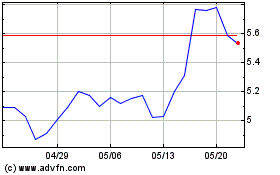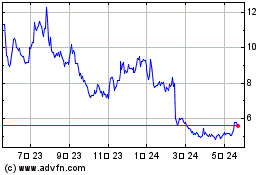- New data showing sustained complete renal response with
LUPKYNIS through three years
- Monthly kidney function assessment no longer required after
first year of treatment
- Safety profile remains unchanged and is aligned with the safety
findings in the AURORA clinical program
Aurinia Pharmaceuticals Inc. (NASDAQ: AUPH) (Aurinia or the
Company) today announced that the FDA has approved a label update
for LUPKYNIS. The updated label no longer includes language
indicating that the safety and efficacy of LUPKYNIS has not been
established beyond one year. The label now includes three-year data
from the AURORA 2 double-blind, placebo-controlled extension study,
which assessed the long-term safety and tolerability of LUPKYNIS in
combination with mycophenolate mofetil (MMF) and low-dose
glucocorticoids, compared with MMF and low-dose glucocorticoids
alone, in adults with active lupus nephritis (LN) who completed the
Phase 3 AURORA 1 clinical trial.
A post hoc analysis of data from the extension study now
included in the label showed that, among the 179 patients receiving
LUPKYNIS and 178 patients receiving placebo in AURORA 1, 20.1%
(n=36) and 11.8% (n=21) achieved sustained complete renal response
(SCRR), respectively. SCRR was defined as achieving renal response
at month 12 of AURORA 1 and maintaining renal response at
subsequent clinic visits through the end of the extension study at
month 36. The label also notes that 21.8% (n = 39) of patients
receiving LUPKYNIS, and 23% (n = 41) in the placebo arm, had
missing data at the end of the first year or by the end of the
two-year extension study, and therefore have an unknown status for
sustained complete renal response.
The updated label also provides new guidance for monitoring
kidney function in patients taking LUPKYNIS. The label indicates
that physicians should assess eGFR every two weeks for the first
month of treatment, every four weeks through the first year, and
quarterly thereafter. The label had previously stated that eGFR
should be assessed every four weeks for the duration of treatment.
The updated LUPKYNIS label supports quarterly monitoring of eGFR
after the first year of treatment, which is more consistent with
current standard clinical care.
“Data from our AURORA 2 extension study included in the LUPKYNIS
label showed a maintenance of sustained complete renal response
with LUPKYNIS in combination with MMF and low-dose glucocorticoids,
at every time point assessed through three years, relative to MMF
and low-dose glucocorticoids alone. This notable outcome is aligned
with treatment guidelines calling for use of LUPKYNIS for at least
three years to reduce proteinuria. Additionally, guidance on
monitoring kidney function quarterly after the first year of
LUPKYNIS treatment reflects the reality of clinical practice.
Overall, this label update provides physicians with important
information to treat and manage their LN patients,” said Dr. Greg
Keenan, Chief Medical Officer of Aurinia.
The safety profile of LUPKYNIS in the updated label remains
unchanged and is aligned with the safety findings in the AURORA
Clinical Program.
The updated label also provides additional lactation data on the
transfer of LUPKYNIS to breast milk based on a twice daily dosing
regimen. This information will be useful to lactating women and
their health care providers who need to make informed decisions
about breast feeding while taking LUPKYNIS.
About the AURORA Clinical Program
In AURORA 1 (referred to in label as Study 1), a 12-month, phase
3, double-blind, randomized-controlled pivotal study, the efficacy
and safety of voclosporin was compared with a control group in
achieving CRR in patients with LN. AURORA 1 demonstrated the
clinical superiority of voclosporin with mycophenolate mofetil
(MMF) and low-dose glucocorticoids compared to MMF and low-dose
glucocorticoids alone. Significantly more patients in the
voclosporin group achieved a CRR at 52 weeks of treatment and did
so significantly faster than those in the control group. The safety
profile in AURORA 1 was comparable between treatment groups, in
line with previous studies; no new safety concerns were observed.
Results from the completed Phase 3 randomized, double-blind,
placebo-controlled, multicenter AURORA 1 study were published in
The Lancet.
AURORA 2 (referred to in label as Study 1 extension), a Phase 3,
double-blind, extension study assessed the long-term safety and
tolerability of voclosporin, in addition to MMF and low-dose
glucocorticoids, for the treatment of patients with active LN.
Voclosporin was well tolerated with no new or worsening safety
signals in the extension study. Clinical efficacy over three years
of treatment was maintained, as observed by maintenance of urine
protein creatinine ratio reductions, sustained complete renal
response and preserved kidney function, suggesting a positive
benefit-risk profile for voclosporin in LN patients. Full results
of the extension study were published in Arthritis &
Rheumatology, the official peer-reviewed journal of the American
College of Rheumatology.
Patients who completed 12 months of treatment in the Phase 3
AURORA 1 study were eligible to enroll in the AURORA 2 extension
study with the same randomized treatment of voclosporin or placebo,
in combination with MMF (target dose of 2 g/day) and low-dose
glucocorticoids (target dose of ≤2.5 mg/day), for an additional 24
months.
A total of 216 LN patients continued into the extension study,
with 116 patients in the voclosporin group and 100 patients in the
control group; 90 and 78 patients, respectively, received 36 months
of total treatment at the completion of the study. Study drug dose
changes decreased over time.
About LUPKYNIS®
LUPKYNIS® (voclosporin) is the first U.S. Food and Drug
Administration and European Commission approved oral medicine for
the treatment of adult patients with active lupus nephritis (LN).
LUPKYNIS® is a second generation calcineurin inhibitor (CNI) with a
dual mechanism of action, acting as an immunosuppressant through
inhibition of T-cell activation and cytokine production and
promoting podocyte stability in the kidney. The AURORA Clinical
Program, comprised of the AURORA 1 pivotal trial and AURORA 2
extension trial, demonstrated the importance of LUPKYNIS® plus
standard of care to preserve kidney health in patients with active
LN without reliance on chronic high-dose glucocorticoids. It is the
only clinical program to include three years of LN treatment and
follow-up with mycophenolate mofetil (MMF) and steroids.
About Lupus Nephritis
Lupus Nephritis (LN) is a serious manifestation of systemic
lupus erythematosus (SLE), a chronic and complex autoimmune
disease. LN affects approximately 120,000 people in the U.S. and
disproportionately affects women and people of color. People living
with LN have high unmet needs and often face significant barriers
to optimal care. If poorly controlled, LN can lead to permanent and
irreversible tissue damage within the kidney. Medical guidelines
recommend that all SLE patients receive routine LN screenings at
every visit. Guidelines also note that delaying LN diagnosis has
profound prognostic repercussions. Yet, research shows that
approximately 50% of SLE patients are not screened for LN and 77%
of people with LN go untreated. Aurinia is committed to improving
health outcomes for people living with LN by educating patients and
providers on the critical need for routine screening and
transformative therapies that can help improve health outcomes.
About Aurinia
Aurinia Pharmaceuticals is a fully integrated biopharmaceutical
company focused on delivering therapies to people living with
autoimmune diseases with high unmet medical needs. In January 2021,
the Company introduced LUPKYNIS® (voclosporin), the first
FDA-approved oral therapy dedicated to the treatment of adult
patients with active lupus nephritis. The Company’s head office is
in Edmonton, Alberta, its U.S. commercial office is in Rockville,
Maryland. The Company focuses its development efforts globally.
INDICATION AND IMPORTANT SAFETY INFORMATION
INDICATION
LUPKYNIS® is indicated in combination with a background
immunosuppressive therapy regimen for the treatment of adult
patients with active LN. Limitations of Use: Safety and efficacy of
LUPKYNIS have not been established in combination with
cyclophosphamide. Use of LUPKYNIS is not recommended in this
situation.
IMPORTANT SAFETY INFORMATION
BOXED WARNINGS: MALIGNANCIES AND SERIOUS INFECTIONS
Increased risk for developing malignancies and serious
infections with LUPKYNIS or other immunosuppressants that may lead
to hospitalization or death.
CONTRAINDICATIONS: LUPKYNIS is contraindicated in
patients taking strong CYP3A4 inhibitors because of the increased
risk of acute and/or chronic nephrotoxicity, and in patients who
have had a serious/severe hypersensitivity reaction to LUPKYNIS or
its excipients.
WARNINGS AND PRECAUTIONS
Lymphoma and Other Malignancies: Immunosuppressants,
including LUPKYNIS, increase the risk of developing lymphomas and
other malignancies, particularly of the skin. The risk appears to
be related to increasing doses and duration of immunosuppression
rather than to the use of any specific agent.
Serious Infections: Immunosuppressants, including
LUPKYNIS, increase the risk of developing bacterial, viral, fungal,
and protozoal infections, including opportunistic infections. This
may lead to serious, even fatal, outcomes.
Nephrotoxicity: LUPKYNIS, like other calcineurin
inhibitors (CNIs), may cause acute and/or chronic nephrotoxicity.
The risk is increased if administered with drugs associated with
nephrotoxicity. Monitor eGFR regularly.
Hypertension: Hypertension is a common adverse reaction
of LUPKYNIS therapy that may require antihypertensive therapy.
Monitor blood pressure regularly.
Neurotoxicity: LUPKYNIS, like other CNIs, may cause
neurotoxicities that if severe can include posterior reversible
encephalopathy syndrome, delirium, seizure, and coma; others
include tremor, paresthesia, headache, and changes in mental status
and/or motor and sensory functions. Monitor for neurologic
symptoms.
Hyperkalemia: Hyperkalemia, which may be serious and
require treatment, has been reported. Concomitant use of agents
associated with hyperkalemia may increase the risk for
hyperkalemia. Monitor serum potassium periodically.
QTc Prolongation: LUPKYNIS prolongs the QTc interval in a
dose-dependent manner when dosed higher than the recommended lupus
nephritis therapeutic dose. The use of LUPKYNIS in combination with
other drugs that are known to prolong QTc may result in clinically
significant QT prolongation.
Immunizations: Avoid the use of live attenuated vaccines
during treatment with LUPKYNIS. Inactivated vaccines noted to be
safe for administration may not be sufficiently immunogenic during
treatment with LUPKYNIS.
Pure Red Cell Aplasia: Cases of pure red cell aplasia
have been reported in patients treated with another CNI. If PRCA is
diagnosed, consider discontinuation of LUPKYNIS.
ADVERSE REACTIONS
The most common adverse reactions (>3%) were glomerular
filtration rate decreased, hypertension, diarrhea, headache,
anemia, cough, urinary tract infection, abdominal pain upper,
dyspepsia, alopecia, renal impairment, abdominal pain.
Drug-Drug Interactions: Avoid co-administration of
LUPKYNIS and strong CYP3A4 inhibitors or with strong or moderate
CYP3A4 inducers. Co-administration of LUPKYNIS with strong CYP3A4
inhibitors is contraindicated. Reduce LUPKYNIS dosage when
co-administered with moderate CYP3A4 inhibitors. Avoid use of
LUPKYNIS with strong or moderate CYP3A4 inducers.
SPECIFIC POPULATIONS
Pregnancy: Avoid use of LUPKYNIS.
Lactation: Consider the benefits and risks of LUPKYNIS
and possible risks to the fetus when prescribing LUPKYNIS to a
lactating woman.
Renal Impairment: LUPKYNIS is not recommended in patients
with baseline eGFR ≤45 mL/min/1.73 m2 unless benefit exceeds risk.
If used in this population, reduce LUPKYNIS dose.
Hepatic Impairment: For mild or moderate hepatic
impairment, reduce LUPKYNIS dose. Avoid use with severe hepatic
impairment.
Please see Prescribing Information, including Boxed Warning, and
Medication Guide for LUPKYNIS.
View source
version on businesswire.com: https://www.businesswire.com/news/home/20240430439216/en/
Media & Investor Inquiries: Andrea Christopher,
Corporate Communications & Investor Relations,
achristopher@auriniapharma.com ir@auriniapharma.com
Aurinia Pharmaceuticals (NASDAQ:AUPH)
過去 株価チャート
から 1 2025 まで 2 2025

Aurinia Pharmaceuticals (NASDAQ:AUPH)
過去 株価チャート
から 2 2024 まで 2 2025
